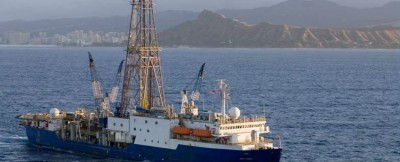A Mission to Drill Right through the Earth’s Crust

This week marks the start of a new project to drill below Earth’s crust into the planet’s mantle – that rocky shell a couple of thousand kilometres thick. Geologists have been trying for almost 60 years to reach this depth, but no one has yet succeeded: the latest mission might just have the technology and the funding to make it happen.
The drill ship JOIDES Resolution will shortly be setting off from Sri Lanka to a point in the southwestern Indian Ocean known as Atlantis Bank. Once it reaches its destination, the ship will lower a drill bit and tunnel through some 1.5 kilometres (almost a mile) of solid rock, taking core samples as it goes. That’s as far as the plan stretches – if the JOIDES Resolution is successful in its mission, future projects will have to take over in the drive to the boundary between Earth’s crust and mantle.
Why Atlantis Bank? Scientists believe the crust-mantle division is marked by a feature known as the Mohorovičić discontinuity, or ‘Moho’ for short. Moho is believed to be particularly near the surface at Atlantis Bank, which should make it easier to reach. There are also fewer hard-to-crack crustal rocks in the region.
Making it down to this unexplored frontier is “one of the great scientific endeavours of the century”, according to expedition co-leader Henry Dick. Dick and his colleagues hope to make it further than the first team to attempt the drill did – oceanographer Walter Munk and a group of fellow geologists got down to 183 metres in 1960 before costs spiralled out of control and the initiative was cancelled.
Reaching the Earth’s mantle is the ultimate goal, but there are plenty of other aims for the mission along the way. The scientists involved want to study more about the behaviour of molten rock and the way it forms fresh ocean crust as it rises from the interior of our planet. Rock cores will be examined for microorganisms too, so it’s possible that a series of biological discoveries are going to be made along the way as well.
“We live on this Earth and we ought to know something about what happens beneath us,” says original pioneer Walter Munk, who is keeping a close eye on the new project.
Henry Dick has actually drilled down to 1.5 km at the Atlantis Bank before – on that occasion, in 1997, the drilling pipe broke in high winds and plugged up the hole that had been created. Munk is insistent that the new mission won’t meet the same fate, and if the team reaches its target, they’ll be looking for more funding to continue the work.
The first phase of the project is scheduled to run until 30 January.

